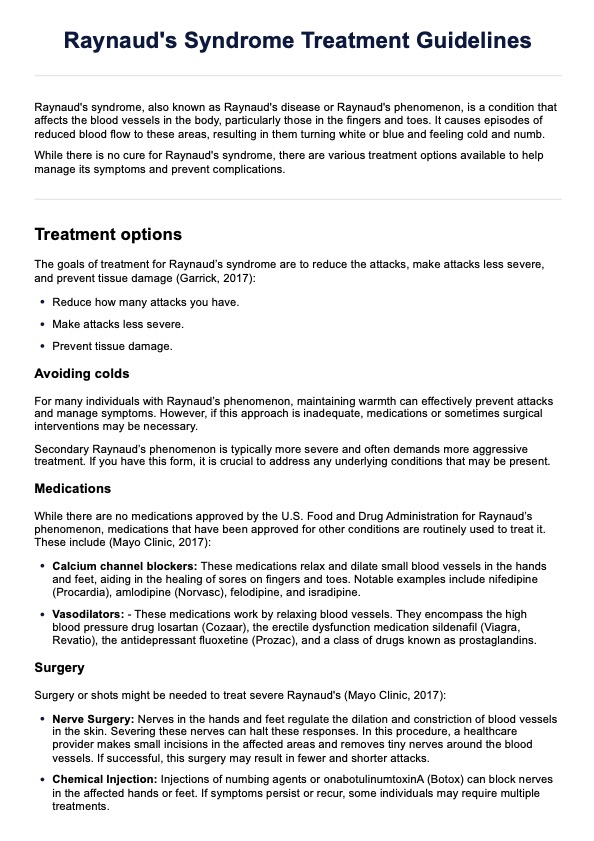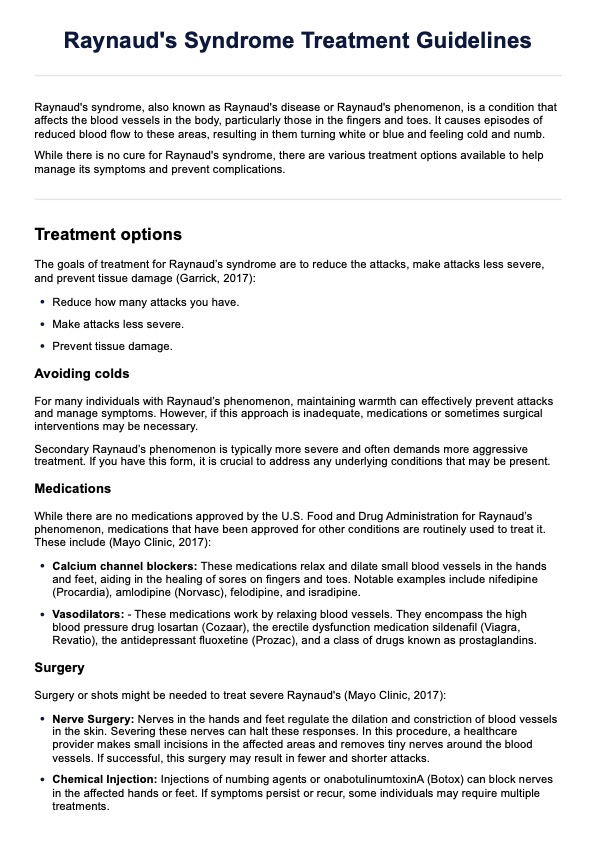Raynaud's Syndrome Treatment Guidelines
Discover Raynaud's disease: signs, symptoms, diagnosis, and treatment. Download our free Raynaud's Syndrome Treatment Guidelines for healthcare professionals.


What is Raynaud's disease?
Raynaud's disease is also known as Raynaud's syndrome or Raynaud's phenomenon. It is a condition in which small blood vessels in extremities like fingers and toes overreact to cold weather or emotional stress, causing reduced blood flow, color changes, numbness, and pain. The Raynaud phenomenon is sometimes associated with high blood pressure and musculoskeletal and skin diseases such as scleroderma, lupus, rheumatoid arthritis, and Sjögren’s disease (Garrick, 2017).
Anyone can get Raynaud’s phenomenon, but certain factors increase the risk. The primary form has no known cause, affects more women than men, usually occurs before age 30, and often has a genetic link. The secondary form is associated with medications for migraines or attention deficit hyperactivity disorder (ADHD) - and environmental factors like operating vibrating tools often.
Signs and symptoms of Raynaud's disease
Some common signs and symptoms of Raynaud's disease include:
- Color changes in fingers or toes, typically turning white, blue, or red
- Numbness or tingling sensation in affected areas
- Pain and discomfort
- Cold extremities
- Difficulty moving affected fingers or toes
In severe cases, ulcers or gangrene may develop on the fingers or toes. Seeking medical attention if you experience any of these symptoms is essential.
Raynaud's Syndrome Treatment Guidelines Template
Raynaud's Syndrome Treatment Guidelines Example
How do healthcare professionals diagnose Raynaud's syndrome?
Diagnosing Raynaud's syndrome involves clinical evaluation and diagnostic tests to ensure an accurate diagnosis.
Clinical evaluation
As a health care provider, you can begin with a detailed medical history and physical exam. Look for symptoms such as color changes in fingers and toes, numbness, and pain, and consider how often these symptoms occur, how long they last, and what triggers them in each patient.
Key diagnostic tests
To confirm Raynaud's syndrome and rule out other conditions, the following tests are commonly used:
- Nailfold capillaroscopy: Examines the tiny blood vessels near the fingernails under a microscope to spot abnormalities.
- Antinuclear antibody (ANA) test: This test looks for antibodies that may indicate autoimmune disorders, which can be related to secondary Raynaud's.
- Complete blood count (CBC): You can use this to detect issues like anemia or infections.
- Erythrocyte sedimentation rate (ESR): Measures inflammation levels in the body, which can be linked to autoimmune diseases.
- Urinalysis: Use this to check for kidney issues and other systemic conditions.
- Pulse volume recording: Measures blood flow to the fingers and toes to identify vascular problems.
- Rheumatoid factor (RF) test: This test identifies antibodies associated with rheumatoid arthritis, which can present symptoms similar to Raynaud's.
Using this approach, you can diagnose Raynaud's syndrome accurately and create an effective treatment plan tailored to your patient's needs.
How do healthcare professionals treat Raynaud's syndrome?
Effectively managing Raynaud's syndrome involves lifestyle changes, medical treatments, and ongoing monitoring. Below is a comprehensive guide to the key approaches you can use.
Lifestyle modifications
Encourage patients to adopt specific lifestyle changes as a fundamental step. Advise them to avoid cold temperatures, manage stress effectively, quit smoking, and exercise regularly to enhance blood circulation.
Medications
You may need to prescribe certain medicines to manage symptoms. Common options include calcium channel blockers like nifedipine, vasodilators like losartan and sildenafil, and topical treatments like nitroglycerin cream.
Surgical interventions
For worsening symptoms or severe Raynaud's, consider surgical interventions. These procedures can include sympathectomy, which involves cutting nerves to reduce blood vessel constriction that limits blood flow, or nerve block injections.
Home remedies
Suggest home remedies that can help manage Raynaud's syndrome. Advise patients to warm their hands and feet, use hand warmers and insulated gloves, and avoid medications that narrow blood vessels. These are all helpful for mild symptoms.
Monitoring and follow-up
Monitor your patients regularly to manage Raynaud's syndrome effectively. Check for the development of painful sores or skin ulcers, the progression of symptoms, and the effectiveness of treatment plans for primary Raynaud's syndrome.
Additional treatments
Additional treatments like physical therapy to improve circulation and biofeedback techniques for stress management should be considered.
By combining these approaches, you can help patients manage Raynaud's syndrome more effectively, improving their quality of life and reducing the severity of symptoms.
How to use our Raynaud's Syndrome Treatment Guidelines template
Our Raynaud's Syndrome Treatment guidelines template gives healthcare professionals clear and practical information to ensure patient care for Raynaud's attacks. Here's how to use the template:
Step 1: Download the guidelines
Get a copy of the handout using the link on this page or via the Carepatron app. You can also find it in the resources library.
Step 2: Print or use the digital copy
You can choose to print out the handout or use the digital copy on your electronic device. Whichever format you choose, make sure it is easily accessible during consultations with patients.
Step 3: Familiarize yourself with the content
Take some time to read through the guidelines and familiarize yourself with its contents. This will ensure that you understand the information provided and can effectively communicate it to your patients.
Step 4: Use the template during patient consultations
During patient consultations, refer to the handout as a guide for providing care and treatment options.
Step 5: Save and share
After using the guidelines, save it for future reference or share it with other healthcare professionals who may benefit from it.
References
Garrick, N. (2017, April 10). Raynaud’s Phenomenon. National Institute of Arthritis and Musculoskeletal and Skin Diseases. https://www.niams.nih.gov/health-topics/raynauds-phenomenon
Commonly asked questions
Primary Raynaud's disease is not linked to other diseases and is typically less severe. Secondary Raynaud's syndrome (Raynaud's phenomenon) is associated with underlying diseases like connective tissue diseases and can cause more severe symptoms.
Raynaud's syndrome affects up to 1 in 20 people in the U.S. Primary Raynaud's is more common, while the secondary form, linked to underlying diseases, is less common but more serious.
Healthcare professionals should evaluate symptoms, perform physical exams, and conduct diagnostic tests like nailfold capillaroscopy and blood tests to differentiate between primary and secondary forms.
Regular follow-ups are vital to monitor symptom progression, treatment effectiveness, and the development of sores. Therapies should be adjusted based on the patient's response and underlying disease progression.

.jpg)





































































































